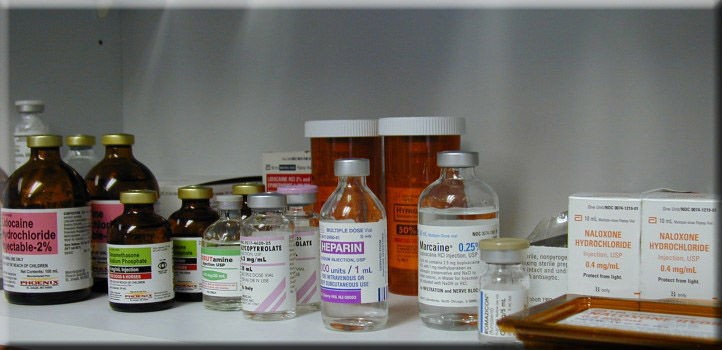 |
Veterinary Anesthesia & Analgesia Support Group |
| Practical Information for the Compassionate Veterinary Practitioner |
|
| HOME |
 |
||
|
|
||
| Alphabetical Drug Summaries | ||
| Dr. Bob Stein | ||
1) KETAMINE
a) Classification
i) Dissociative injectable anesthetic agent
b) General Information
i) Usually combined with Acepromazine or a Benzodiazepine (Diazepam or Midazolam) for induction ii) Provides analgesia at low doses when used in conjunction with an opioid agent c) Advantages/Recommended use
i) Routine induction ii) Reasonable choice for stable valvular heart disease patients iii) Give 5 mg/lb orally for fractious cats d) Cautionary Information
i) Avoid if: (1) History of seizures (2) Intracranial disease is suspected (3) Significant renal disease is present ii) Corneal desiccation can occur (1) Corneal protection is required iii) Initially causes myocardial depression generally followed by indirect sympathetic stimulation (1) Increased heart rate can be detrimental for: (a) Hypertrophic cardiomyopathy (b) Hyperthyroid patients (c) Pheochromocytomas e) Dosage Information
i) Routine induction - Ketamine & Diazepam (1) Dog & Cat (a) Draw up 1.0 ml of 50/50 mixture per 20lb (i) Give ½ initially, then to effect (ii) Reduce dose by 30% - 50% if depressed or heavily sedated by pre-meds (b) 2 mg/kg (1 mg/lb) lidocaine bolus may be administered to dogs following initial ketamine/diazepam bolus to reduce total ketamine/diazepam need (c) Keep the unused agent with the patient in the event that the endotracheal tube is dislodged, the patient suddenly becomes very light, etc. (2) IM/SC use - not recommended as diazepam can be painful and less predictably absorbed (a) Diazepam contains propylene glycol ii) Routine induction - Ketamine & Midazolam (1) Cats (a) Ketamine – 5 to 10 mg/kg (2.5 to 5 mg/lb) (i) For younger, fractious cats use 10 mg/kg (5 mg/lb) (ii) For quiet, older cats reduce ketamine to 5 to 8 mg/kg (2.5 to 4 mg/lb) (b) Midazolam – 0.2 to 0.4 mg/kg (0.1 to 0.2 mg/lb) (c) Mix together in same syringe and give IM (2) Dogs – the expense of midazolam makes this unattractive for use in dogs f) Cost
i) Low (for ketamine alone and for ketamine/diazepam combined)
2) KETOPROFEN
a) Classification
i) An NSAID b) General Information
i) Effective anti-inflammatory/analgesic with significant GI side effects if used long term c) Advantages/Recommended use
i) Long acting analgesic injectable for single dose post-op use (1) Duration of effect is 12 to 18 hours (2) Single dose post-op usage has been shown to be free of any side-effect concerns in normal dogs and cats d) Cautionary Information
i) Avoid long term use (1) GI side effects can be substantial ii) Avoid use in combination with corticosteroids (1) Potentially increased ulcerogenic effect iii) Avoid in renal compromised patients iv) Avoid in dehydrated or hypotensive patients e) Dosage Information
i) Dogs – 2.0 mg/kg (0.9 mg/lb) SC one time only ii) Cats – 2.0 mg/kg (0.9 mg/lb) SC one time only f) Cost
i) Very low |
||
| Return to top of page | ||
| Questions or problems regarding this web site should be directed to DRSTEIN@VASG.ORG . Copyright © 2003 ASAH. All rights reserved. Last modified: February 16, 2011 . |
||